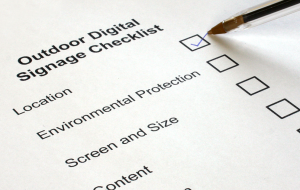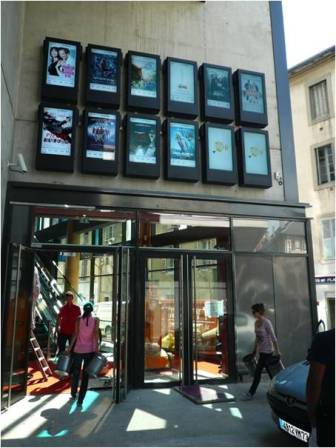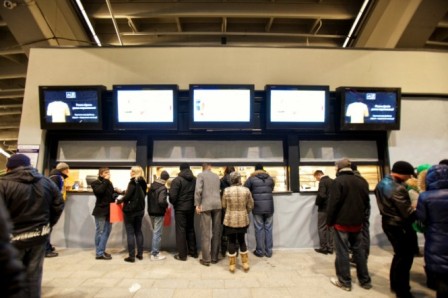Digital signage is a valuable investment for companies and organisations. It has many benefits, including enhancing communications with staff and customers, increasing footfall and acting as a brilliant advertising portal.

There are lots of different kinds of digital signage solutions, and it’s important to spend some time considering what type is right for you. This will help you to get the best from your investment. Whatever your requirements, you will find features and models that will help you achieve them.
Use our digital signage checklist to make sure you’re making the right decisions.
1) Location
Will your digital signage be located indoors or outdoors?
One of the key considerations when it comes to choosing the right digital signage system is where you’re going to put it. The biggest issue here is whether the screen is going to be positioned indoors or outdoors.

Outdoor digital signage is manufactured to be much more hardwearing than indoor systems, and is designed to be able to weather the elements. If you’re planning to install your signage outside, you need to make sure you invest in an appropriate piece of equipment.
How will your digital signage be secured?
Different types of screen come with different securing options. It’s important to think about how you plan to secure your enclosure: by mounting it on the wall, floor or ceiling. Not all screens and enclosures are compatible with all mounting options, so you’ll need to consider this in advance.
Will your screen be facing direct sunlight?
Another important thing to think about, especially if you’re opting for outdoor digital signage, is whether your screen is going to be facing direct sunlight. If it is, you’ll need to make sure you choose a screen that’s designed for this situation. Purpose build screens are not only readable in direct sunlight, they will also be protected from damage by it.
2) Environmental Protection
When you’re choosing a digital signage system, you’ll need to consider how your environment will affect your chosen screen. Screens that are displayed in public areas, either indoor or outdoor, will need to be well protected from temperature, weather and vandals.
When you choose a digital signage system with a high quality enclosure, you can be sure that your screen will be well protected. However, before you choose the right enclosure, it’s important to make sure that you’ve considered how your environment could affect your digital signage equipment.
Will your screen need protection from extreme weather?
You should choose an enclosure based on the weather conditions it will need to contend with. If you are in a part of the world that gets a lot of rain or snow, you’ll need to take this into consideration. Equally, if you experience extremely high temperatures or humidity levels, you’ll need to pick an enclosure that can cope. When you’re choosing an enclosure, think about both the ambient temperature where your screen is going to be displayed, and the most extreme the temperature could go. This information will enable you to choose an enclosure that will work best in your environment.
Is your screen likely to be a target for vandalism?
Another aspect of environmental protection is vandalism. If your screen is going to be unsupervised in a public place, it’s likely that it may be a target for vandals. In these cases, it’s important to drastically reduce the risk of damage by investing in a hardwearing enclosure. The toughest enclosure windows are made from shatterproof polymers and toughened anti-vandal glass that can withstand extremely high impacts without breaking.
3) Screen and Size
What screen size will best fit the application of your digital signage?
The type of screen and size that is best for you depends completely on how you plan to use your LCD digital signage, and where it’s going to be positioned.

There’s a great deal of variety available when it comes to screen size. Whether you go for a small, average or large screen depends on how visible your LCD digital signage needs to be. Screens that are displaying information high up often need to be much bigger than screens on the ground in order to remain visible.
Do you need a screen with high bright?
If your screen is going to be positioned in direct sunlight, you will want to invest in a screen that comes with high bright. Indoor commercial screens typically operate between 300-400 Candela (brightness), but this isn’t enough to contend with the glare and reflections produced by direct sunlight. Screens with high bright feature can display at over 1,500 Candela, which cut these unwanted effects out completely.
4) Content
How do you want to share content?
When you’re choosing digital signage, it makes sense to consider the kind of content you’re going to want to share with it. Many businesses and organisations choose to share advertising messages as well as more informative content.
It’s important to make sure that the messages you want to share are designed to resonate with your audience effectively. One of the best ways to do this is to think about the many different ways that content can be shared using digital signage. Video can be displayed, as well as text, pictures and sounds. If you choose a digital signage touch screen system, you could even share interactive content.
Will you need a network that enables remote content editing?
One of the great things about digital signage is that content can be edited remotely. This means that you can change and remove messages from the system even when you’re not on site. A feature like this can be very helpful: especially if your screens need to react quickly to information changes or local news. If you are going to be needing to edit screen content remotely, you’ll need to ensure that you have a media player and network that supports remote content transfer.
5) Operation
Digital signage solutions can make a big difference to the success of your business or organisation, but they can’t do it on their own. In order to be most effective, screens need to be used as part of a carefully organised strategy.
Have you set business objectives for your digital signage solution?
Before you spend money on digital signage, it’s a good idea to put a set of business objectives together. These could cover how much you want to achieve from your digital signage solutions, including increased sales, footfall and/or advertising revenue. Setting these objectives out in advance will enable you to measure the success of your digital signage and quantify a return on investment over time.
Who will be responsible for maintaining the digital signage?
At this stage it’s also important to set out how you are going to maintain your digital signage solutions. Set out who is responsible for updating content and resolving any problems that might arrive. Investigate what maintenance and ongoing support is included in the price of the machine. Consider, too, what the costs might be in the event of hardware failure, and if you will need to call out a specialist.
Remember:
Digital signage can produce great results for businesses and organisations, but there is a great deal to think about before you make the investment. There are many different kinds of digital signage solutions on the market, and the one that’s right for you will depend on the individual needs and requirements of your company or organisation.
Work your way through our digital signage checklist, and you can be sure you’ll end up with the digital signage option that is just what you need.



Comments are closed.